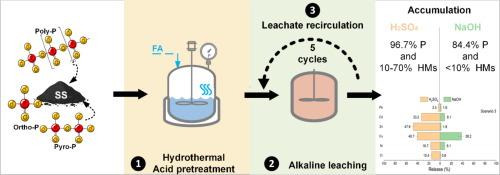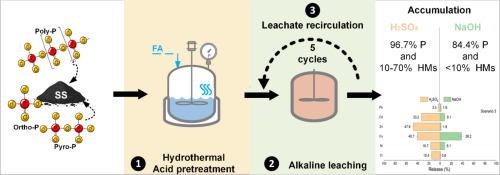串联酸辅助水热处理和抑制重金属萃取技术实现污水污泥中高纯度磷的回收
IF 9
1区 工程技术
Q1 ENGINEERING, CHEMICAL
引用次数: 0
摘要
水热处理(HTP)是一种前景广阔的污水污泥(SS)处理技术,可促进随后通过化学萃取回收磷(P)。本研究提出了一种 HTP 和化学萃取相结合的工艺,以提高磷的回收率。在 HTP 过程中加入有机酸(甲酸和草酸),生成酸介导的水炭(HC):甲酸处理水炭(HC-FA)和草酸处理水炭(HC-OA)。然后使用 H2SO4 和 NaOH 从 HC-FA 和 HC-OA 中提取 P。研究发现,酸助 HTP 增加了碳氢化合物的孔隙率和表面积,从而促进了 P 的提取。使用 H2SO4 浸出时,HC-FA 的磷浸出效率提高了 91.8%,使用 NaOH 浸出时提高了 85.2%。对于 HC-OA,则分别提高了 88.2%(H2SO4)和 83.7%(NaOH)。与 H2SO4 相比,NaOH 沥滤的重金属 (HMs) 释放量明显较低。具体来说,与 H2SO4 沥滤相比,Cr 和 Pb 沥滤量减少了 15 倍,Zn 和 Cd 减少了 10 倍,Cu 和 Ni 减少了 5 倍,这凸显了 NaOH 在更清洁的 P 提取方面的潜力。此外,还进行了浸出液再循环,在减少化学品消耗的同时进一步提高了 P 的回收率。方案 3 涉及在两个周期后补充 1 M 浸出剂,结果表明 P 积累最高(H2SO4 中为 96.7%,NaOH 中为 84.4%),而 HM 释放量最小(NaOH 中为 10%)。这些研究结果突显了有机酸辅助水热处理和浸出液再循环在提高钾回收率和最大限度减少 HM 释放方面的功效,促进了符合循环经济原则的可持续 SS 管理。本文章由计算机程序翻译,如有差异,请以英文原文为准。


Tandem acid assisted hydrothermal treatment and Inhibited heavy metal extraction towards High-Purity phosphorus recovery from sewage sludge
Hydrothermal processing (HTP) is a promising technology for sewage sludge (SS) treatment to facilitate subsequent phosphorus (P) recovery via chemical extraction. This study has proposed a combined HTP and chemical extraction process to improve P recovery. Organic acids (formic acid and oxalic acid) were incorporated during HTP and resulted in acid mediated hydrochar (HC): formic acid treated hydrochar (HC-FA) and oxalic treated hydrochar (HC-OA). Then H2SO4 and NaOH were applied for subsequent P extraction from HC-FA and HC-OA. It is found that acid-assisted HTP increased the porosity and surface area of HC, thereby facilitating P extraction. P leaching efficiency from HC-FA was enhanced by 91.8 % with H2SO4 leaching and 85.2 % with NaOH leaching. For HC-OA, it was increased by 88.2 % (H2SO4) and 83.7 % (NaOH) respectively. NaOH leaching resulted in significantly lower heavy metal (HMs) release compared to H2SO4. Specifically, Cr and Pb leaching were 15-fold lower, Zn and Cd were 10-fold lower, and Cu and Ni were 5-fold lower compared to H2SO4 leaching, highlighting its potential for cleaner P extraction. Furthermore, leachate recirculation was performed to further enhance P recovery with reduced consumption of chemicals. Scenario 3, which involved replenishing the 1 M leaching agent after two cycles, demonstrated the highest P accumulation (96.7 % in H2SO4 and 84.4 % in NaOH) and minimal HM release (<10 % in NaOH). These findings highlight the efficacy of organic acid assisted hydrothermal treatment and leachate recirculation in enhancing P recovery while minimizing HM release, promoting sustainable SS management aligned with circular economy principles.
求助全文
通过发布文献求助,成功后即可免费获取论文全文。
去求助
来源期刊

Separation and Purification Technology
工程技术-工程:化工
CiteScore
14.00
自引率
12.80%
发文量
2347
审稿时长
43 days
期刊介绍:
Separation and Purification Technology is a premier journal committed to sharing innovative methods for separation and purification in chemical and environmental engineering, encompassing both homogeneous solutions and heterogeneous mixtures. Our scope includes the separation and/or purification of liquids, vapors, and gases, as well as carbon capture and separation techniques. However, it's important to note that methods solely intended for analytical purposes are not within the scope of the journal. Additionally, disciplines such as soil science, polymer science, and metallurgy fall outside the purview of Separation and Purification Technology. Join us in advancing the field of separation and purification methods for sustainable solutions in chemical and environmental engineering.
 求助内容:
求助内容: 应助结果提醒方式:
应助结果提醒方式:


